from the canonical "Glory" scenario
Spoiler Alert! If you are a player and have not yet played "Glory", this contains GM-specific material!
Canonical material is under a Creative Commons Attribution-Noncommercial-Share Alike 3.0 Unported License. To view a copy of this license, visit: http://creativecommons.org/licenses/by-nc-sa/3.0/
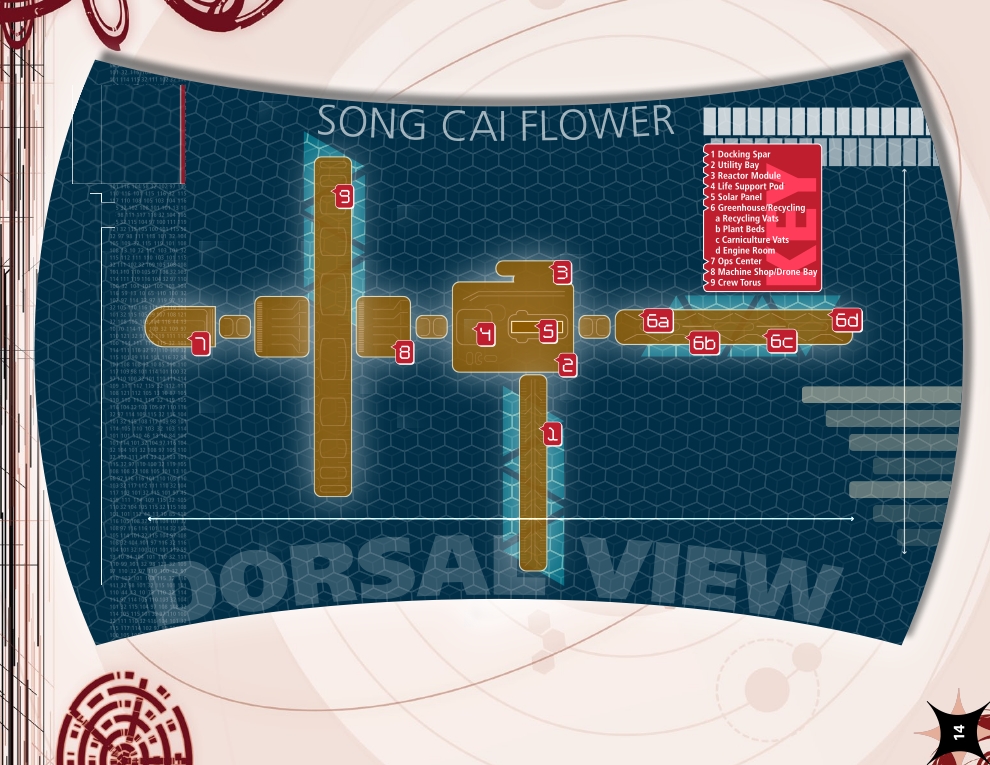
Song Cai Flower Map Key
Area descriptions use the side of the ship from which the solar panel extends as the arbitrary “up” direction. “Left” and “right” directions are relative to a character looking into the area from a given entrance.
1. Docking Spar
The spar is an open truss with a standard docking ring on one end attached to a heavy plastic umbilicus two meters wide. It’s a cheap solution that hasn’t stood up well to extended exposure to space. The docking ring itself is functional, but the umbilicus has been holed by micro-asteroids in many places along its length and won’t pressurize. Characters trying to enter this way will need to stay in their suits. A standard airlock leads from here to the utility bay (Area 2).
Two LLOTVs are docked along the length of the spar. Both have been recently gutted, with engines and power supplies hastily (and sloppily) removed.
2. Utility Bay
This section houses a well-equipped but poorly-kept utility shop. On the “up” wall above, where the solar panel connects, are banks of power storage and monitoring gear. A small airlock on this wall gives easy access to the solar panel spar (Area 5). Characters with Profession skills relating to space- ship or station administration or maintenance who check the power readings realize on an Easy Test (+10) that the trickle of power from the solar array is totally insufficient to operate a ship this size this far out from the sun; therefore, one or more reac- tors must still be online.
Two standard airlocks on opposite sides of the bay lead to the docking spar (Area 1) and reactor module (Area 3). Left and right of the docking airlock are ser- vice airlocks to the greenhouse (Area 6) and machine shop (Area 8). The wall below has a deeply recessed service airlock (about 3 meters) that opens to space and a service crawlway leading to the life support pods (Area 4).
Just inside the bottom service lock are three large fuel tanks. Fuel lines run from these to attitudinal thrusters on the outside of the utility bay and Area 4. These are linked to the thrusters in the ops center (Area 7), but the ops center has its own fuel supply, as well as the manual controls for all of the station’s thrusters. The attitudinal thrusters are sufficient for station keeping and spinning or stopping the torus, but not to move the ship any significant distance. (This was originally done with boosters that have long since been broken down for parts).
The drone Sit is often working here.
3. Reactor Module
From outside, the reactor module looks like a wide, flattened donut with no hole in the middle. For char- acters who have spent a lot of time on or around spaceships, it’s easily recognizable. A standard airlock connects it to the utility bay (Area 2). The door to the reactor is locked, but can be overcome with any of the methods described on pp. 291-292, EP, with a -10 difficulty modifier.
Inside, the donut contains the toroidal magnetic containment chamber common to most fusion reac- tor designs, monitoring equipment, a fuel processor, and conduits for venting spent fuel and waste heat into space. The space inside is cramped, with lots of handholds, and the air is hot. This is one of the better maintained modules on the Flower, but even it looks seriously overdue for a visit from mainte- nance personnel. Two small airlocks on the flat sides (above and below from the viewpoint of the door to Area 2) would give access to space but have been welded shut.
Damage to the reactor walls can temporarily dis- rupt the magnetic containment field, with dangerous results. If a character discharges any kind of firearm or seeker in this area and misses their target with a Severe Failure (MoF 30+), their attack has struck and possibly damaged the reactor wall (see stats below). The containment torus is self-healing (p. 292, EP). If the donut takes enough damage to exceed its Durability or suffers a wound, a superheated jet of plasma escapes the magnetic containment and burns anyone within 10 meters who fails a Fray Test (3d10 + 12 [28] DV, AP -10, resisted with Energy armor). The entire module is also flooded with heavy radia- tion (exact effects to be determined by gamemaster; see p. 201, EP).
| REACTOR STATS | ||
|---|---|---|
| containment wall | ||
| Armor | Durability | Wound Threshold |
| 50 | 200 | 50 |
4. Life Support Pod
From outside, the life support pod is a blocky, heavily shielded box. Some of the planes along its surface are recessed, while along the top side there is a row of four outward-curving surfaces that suggest cylindrical shapes continuing inside the module, possibly storage tanks of some sort. The part-cylindrical surfaces run the width of the module and are capped at its edge by four heavy, circular service hatches. Inside, it’s an orderly but tightly packed maze of condensers, filtra- tion equipment, and algal oxygen vats. The lights in the room are purple UV tubes (to characters who can only see in the visible spectrum) for the algae.
5. Solar Panel
The Flower’s solar panel is a single array about 80 meters long and 7.5 meters wide, projecting from the top of the utility bay (Area 2). Adjacent to it is a small airlock. Though the solar panel provides a nearly neg- ligible amount of power to the station, close examina- tion reveals that it has been put to another purpose. Conductive materials in the panel have been wired to the station’s communication systems, transforming it into a massive antenna array with enough bandwidth for egocasting.
Anyone entering or checking the airlock between the solar panel and the utility bay will find the broken (but not destroyed) remains of Achilles, the custom bot that accompanied Tara Yu. The exsurgents dumped it here for spacing, but never got around to cycling the airlock. Though heavily damaged, the bot may be repaired. It is still carrying the Tortoise AI in a ghostrider module, which is also carrying a copy of the Myrmidon data—and the Glory virus. Careless techs may find themselves exposed to the AOK hack if they fail to take precautions.
6. Greenhouse/Recycling
This is a huge, cylindrical module nearly 100 meters long and 20 meters in diameter, separated into four separate areas (see below). Close inspection reveals that it was once the passenger module on one of the immense, heavy-lift rockets used for evacuations during the Fall. Fittings for acceleration couches and the like are still present, as well as the pre-Fall equiva- lent of airplane safety equipment. At some point, great windows were cut into the module walls, transform- ing it into a greenhouse. Running along the center of the module from the hatch to the utility bay (Area 2) back to the new engineering section (Area 6d) is a one-meter diameter utility conduit with recycling, water, and nutrient feeds. This conduit connects the recycling vats (Area 6a) to the plant beds (Area 6b) and meat vats (Area 6c).
6a. Recycling Vats
The first 20 meters of the module are walled off from the rest and have a foul, septic reek (apply a -10 modifier to all physical and social tests for characters who spend more than a minute in this room without breathing equipment). PCs with any ship or habitat operations-related Knowledge skill immediately real- ize that the recycling system here, while still functional, is working below capacity and suffers from a lack of basic maintenance.
The walls here are crammed with a maze of pipes and conduits connecting recycling equipment (large vats, catalyzer units, and the like) to the life support system, utility bay, machine shop, station plumbing, and the rest of the greenhouse. This system converts biological waste, condensation, and meat growth byproducts from a foul slurry into drinkable water, fertilizer, and trace elements for the fabricators.
6b. Plant Beds
The plant beds occupy the next 50 meters of the module, moving outward from the hatch to the utility bay (Area 2). They end in a translucent wall of heavy plastic, separating them from the carniculture vats (Area 6c). This wall has two hatches giving access to the vats on opposite sides of the axial utility conduit.
Originally designed for use in stronger sunlight, the outer walls of this module are mostly window, though the windows are dingy and in many places completely dirt-caked, letting in only faint starlight from outside. Most of the illumination comes from stacks of hydroponic plant trays radiating out in three or four tiers from the axial utility conduit. Each tier of plants has its own lighting, and the vegeta- tion averages three meters “deep,” moving from the windows toward the utility conduit. The plants grow in tangles, with only a fleet of five or six small flying drones maintaining them. PCs familiar with growing food on space stations will notice that almost the entire crop here is high-yield cereal grains and soy, with virtually no fruits or vegetables. Most of the crop is being auto-harvested and fed into a processor connected to the utility conduit. The processor feeds a thick nutrient line that runs beyond the hatch at the far end of the plant beds, into the next section of the module.
The tangles of vegetation afford good concealment; treat targets hiding among them as having moderate cover (-20). The exsurgents may choose this as an ambush spot due to the ample cover.
Diên, one of the exsurgent drones, is usually here tending to the plants.
6c. Carniculture Vats
The equipment here is the best maintained that the PCs have encountered so far. The walls are lined with massive, green-lit vats designed to grow cultured meat and extrude it in an edible form. Examining the contents confirms what the PCs may already have realized; all of the vats are growing cultured human flesh—mostly thigh muscle tissue, with a few organ meats thrown in for variety.
6d. Engine Room
Separated from the vats (Area 6c) by a hastily-con- structed metal bulkhead with a single large hatch in it, the engine room occupies the last 10 meters of the module—what will be the rear of the ship should the White Khanhs manage to get it under acceleration. The builders didn’t put much effort into radiation shielding. Any character sleeved in an unprotected biomorph who spends more than five minutes in this room loses 5 SOM and other radiation effects the gamemaster desires (p. 201, EP) until they receive medical attention in a healing vat.
Unlike the attitudinal drives elsewhere on the ship, the rockets cannibalized from the other spacecraft and attached outside here are nuclear, so there are no fuel tanks. Instead, thrust mass comes from two large water pipes running from the utility conduit in 6c. Apparently the designer’s plan was to pull thruster mass directly from the station’s water supply—a suicidal plan, on the face of it, as it would exhaust all of the station’s water, as a Hardware: Aerospace or appropriate Knowledge skill will discern. The dormant Mother, however, would survive long enough to be immolated by the sun.
7. Ops Center
From the outside, ops resembles the bridge module found on any bulk freighter, implying that it probably contains sensor systems, emergency thrusters and life support, and a lot of computing power. The inside, however, is far different than expected. The walls, windows, and equipment here are all covered in a 40 centimeter-thick layer of pinkish-gray human flesh— the transmogrified form of Phuong Lê, the exsurgent Mother (discovering this fact inflicts mental stress; see p. 24). The flesh is thicker in some places where Phuong Lê’s many wombs swell with embryos. Every surface moves gently to the slow rhythm of respiration and the flesh occasionally shifts from the pre-natal stirrings of exsurgent brood. Here and there, manual instrument banks, designed to operate the station in case the ship’s mesh fails, protrude from the flesh. The room is lit only by instrument panels. Lê’s bloated face peers up from a hump of flesh, surrounded by six spiky maws opening on what used to be her throat. When not chomping on raw meat fed to them by Sit, all seven mouths inces- santly sing a soft lullaby. Drifting slightly above and behind Lê’s face are her arms, which have metamor- phosed into a pair of 3 meter-long prehensile tentacles with stubby grasping digits at their tips.
Wei, Dexter Vo’s muse, pays close attention to surveillance feeds coming from this module, and any detected intruders will be attacked soon after. Char- acters exposed to Lê’s body fluids (which could easily happen in a firefight) have the standard chance of contracting Glory (p. 19). Lê will initially ignore PCs, but if they try to damage her, she will lash out with her tentacles and psi sleights.
Lê’s breeder mate, Bian, is usually found here, in- seminating the Mother. One of the drones, Wu, is typi- cally here as well, feeding and caring for Phuong Lê.
8. Machine Shop/Drone Bay
The station’s fleet of harvester drones are still opera- tional, and PCs may occasionally see them entering or leaving the station alone or in small groups. There are ten drones in all, and at any time half of them will be away from the ship harvesting water and other materials from nearby rocks.
The machine shop contains a large-format cornucopia machine, a number of smaller makers, materials storage, tools, and a pair of repair tender rocket sleds designed to move heavy equipment out to docked shuttles. Two flexbots (p. 144, EP) are racked on one wall; neither is occupied, but they’re in working condition. There are two large service airlocks, one of which is occupied by a rocket sled, and a bank of vacsuits. In the center of the room is the immense joint around which the station’s crew torus rotates. Two of the torus’s four spokes contain lift shafts, while the other two have dimly lit open floatways with ladder rungs running along their sides.
The Myrmidon hardware fragments are here, hap- hazardly stacked in a series of bins shoved under a workbench. They are relatively easy to find, as they look like large chunks of slightly-charred military satellite. The smallest piece is about 20 centimeters long, while the largest is over 2 meters. The very size of them should make PCs nervous, as the amount of computing power in a 2 meter-long processing block is almost sufficient to birth a seed AI—like the TITANs. Such systems are illegal in most places. The pieces are self-documenting, and connecting a power supply to them is a simple matter for any character with Hard- ware skill. If any character powers the fragments up and examines their documentation, they are subject to the AOK hack effect of the Glory virus (p. 19).
Sitting innocuously on the workbench above the Myrmidon fragments is the Glory nanobot hive built by Phuong Lê. From the outside, it doesn’t look like exsurgent tech; Lê built the alien-looking part inside of an old perimeter defense drone fuselage. If powered up, it releases a mist of Glory nanobots that expands in a sphere at a rate of 1 meter per Action Turn to a maximum volume of 5 meters across. Characters standing in the area of effect as the swarm expands must make a Fray Test to get out of the way. Failure means the character has the standard chance of con- tracting Glory from physical exposure (p. 19).
Because the machinery in this room provides a lot of hard cover (-10 to -30 modifiers), this is another likely location for the exsurgents to set up an ambush.
9. Crew Torus
The rotating crew torus is 250 meters in diameter, with over 750 meters of floor space. Gravity at floor level is Mars standard (0.36 g). Large portions of the torus are unused space, filled with junk or simply empty. Access is obtained via spokes leading to the machine shop (Area 8), or by two small airlocks on opposite ends of the torus.
9a. Med Bay/Resleeving Center
This area includes four healing vats (p. 326, EP), ten morph storage tanks (half of which are occupied by morphs transformed into immolator exsurgents), an ego bridge (p. 328, EP), a fabber (p. 327, EP) for making and disposing of medical supplies, and a fully operational examination and surgical setup.
9b. Rec Area/Kitchen
The rec area is a maze of couches and padded chairs, most of which face a huge holovid screen. Also pres- ent are the smashed wreckage of a three-dimensional foosball table, a board game table, a sound-proofed chamber containing a well-equipped S&M dungeon, and a racquetball court. The kitchen has two huge walk-in refrigeration units, food makers, traditional cooking equipment, and a huge, gleaming meat grinder designed to combine flesh with a glutinous rice-derived paste to extrude udon noodles. Almost all of the food in the refrigeration unit is meat, some of it recognizably human. In contrast to many of the other rooms on the station, the kitchen is curiously—almost clinically—clean and tidy.
Four of the breeders—Bui, Quang, Sang, and Thanh—are usually here, along with Dexter Vo and Ji.
9c. Crew Quarters
The crew quarters contain twenty rooms of various sizes. The drones share small rooms with a bunk beds, except for Dexter Vo and Ji, who sleep in a sumptuous but rather tacky crime lord pimp den with an immense circular bed, mirrored ceiling, and lots of bad erotic art. The breeders don’t sleep anymore, but anyone searching these rooms will find personal effects of theirs from before their transformations. The remain- ing rooms are either unoccupied or belong to people who were long ago eaten. Sammy Li’s personal effects, including the cufflinks, can be found in a duffel bag in an otherwise empty room here, just as he described.
The remaining 3 drones—Quy, Smith, and Nong— are here when not attending to various tasks.
by GJD
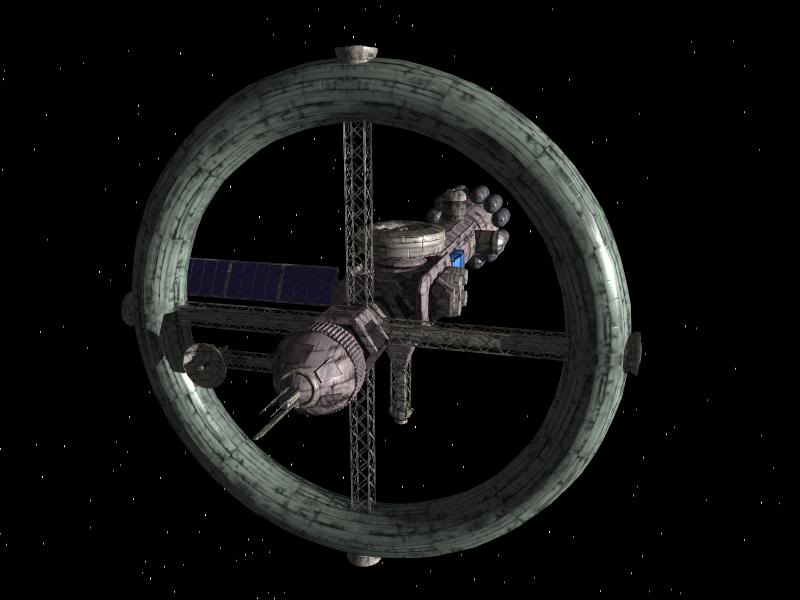
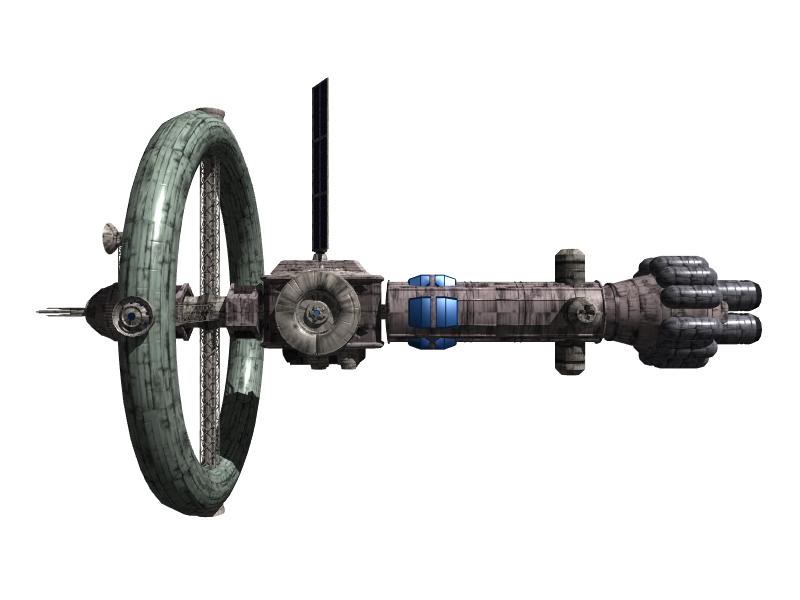
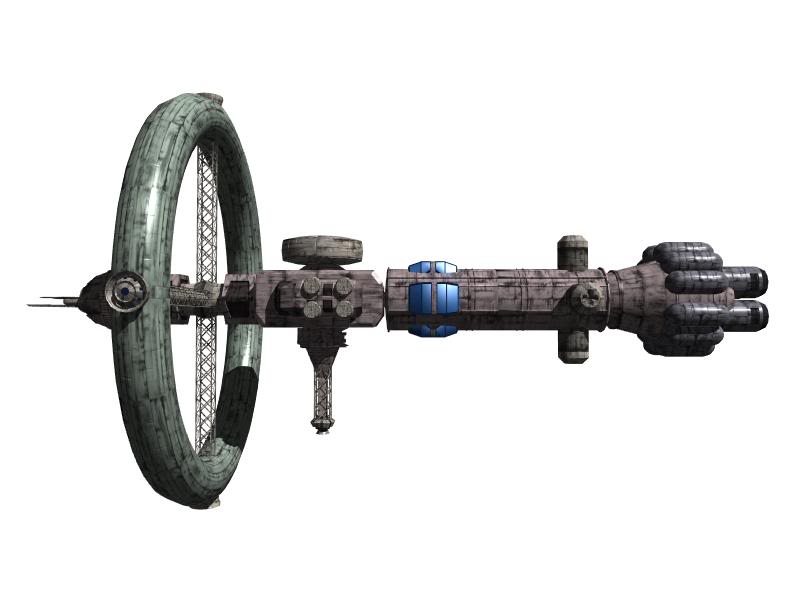
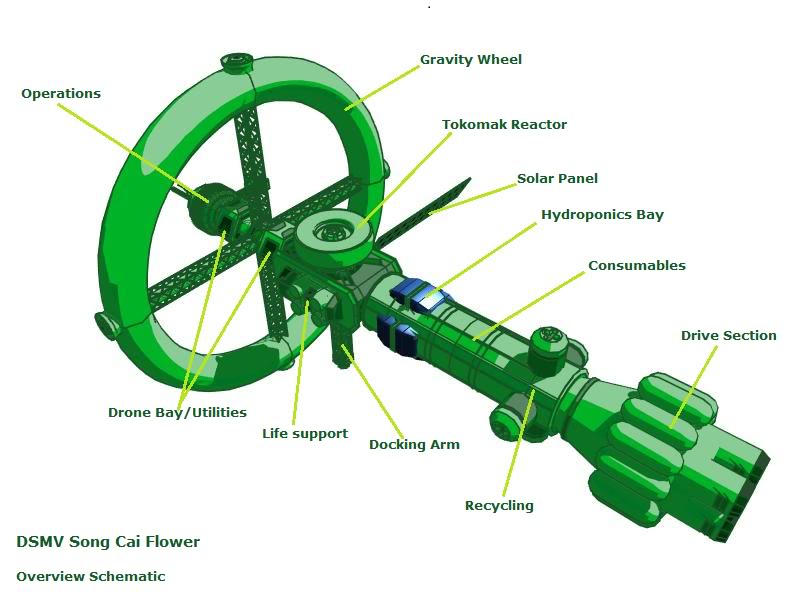
by Samuel Penn